Abstract
Multi-reservoir operation planning is a complex task involving many variables, objectives, and decisions. This paper applies a hybrid method using genetic algorithm (GA) and linear programming (LP) developed by the authors to determine operational decisions for a reservoir system over the optimization period. This method identifies part of the decision variables called cost reduction factors (CRFs) by GA and operational variables by LP. CRFs are introduced into the formulation to discourage reservoir depletion in the initial stages of the planning period. These factors are useful parameters that can be employed to determine operational decisions such as optimal releases and imports, in response to future inflow predictions. A part of the Roadford Water Supply System, UK, is used to demonstrate the performance of the GA-LP method in comparison to the RELAX algorithm. The proposed approach obtains comparable results ensuring non zero final storages in the larger reservoirs of the Roadford Hydrosystem. It shows potential for generating operating policy in the form of hegging rules without a priori imposition of their form.
Similar content being viewed by others
References
Bertsekas, D. P., 1991, Linear Network Optimisation: Algorithms and Codes, MIT Press Cambridge, USA.
Bessler, F. T., 1998, Linear Network Optimisation and Identification of Control Rules to Develop a General Operating Policy for a Water Supply System, Master's Thesis, School of Engineering and Computer Science, University of Exeter, Exeter, UK.
Bessler, F. T., Savic, D. A., and Walters, G. A., 2001, ‘Water reservoir control with data mining,’ J. Water Res. Plan. Manage. ASCE 129(1), 26–34.
Cai, X., Mckinney, D., and Lasdon, L. S., 2001, ‘Solving nonlinear water management models using a combined genetic algorithm and linear programming approach,’ Advances in Water Resources. 2(6), 667–676.
Goldberg, D. E., 1989, Genetic Algorithms in Search, Optimization, and Machine Learning, 2nd ed., Addison-Wesley, Reading, Mass.
Kuczera, G., 1989, ‘Fast multireservoir multiperiod linear programing models,’ Water Resources Research 25(2), 169–176.
Labadie, J. W., 2004, ‘Optimal operation of multireservoir systems: State-of-the-art review,’ J. Water Res. Plan. Manage. ASCE 130(2), 93–111.
Meier, R. W. and Barkdoll, B. D., 2000, ‘Sampling design for network model calibration using genetic algorithms,’ J. Water Res. Plan. Manage. ASCE 126(4), 245–250.
Michalewicz, Z., 1992, ‘Genetic Algorithms + Data Structures = Evolutionary Programs,’ Spring-Verlag, New York.
Neelakantan, T. R. and Pundarikanthan, N. V., 2000, ‘Neural Network-based simulation-optimization model for reservoir operation,’ J. Water Res. Plan. Manage. ASCE 126(2), 57–64.
Oliveira, R. and Loucks, D. P., 1997, ‘Operating rules for multireservoir systems,’ Water Resourses Research 33(4), 839–852.
Pereira, M. V. F and Pinto, L. M. V. G., 1985, ‘Stochastic optimization of a multi-reservoir hydroelectric system: A decomposition approach,’ Water Resources Research 21(6), 779–792.
Reis, L. F. R., Walters, G., Savic, D., and Chaudhry, FH., 2004, ‘Multi-Reservoir Operation Planning using Hybrid Genetic Algorithm and Linear Programming (GA-LP): An Alternative Stochastic Approach’ (Accepted for Publication in Journal of Water Resources Management).
Simonovic, S. P., 1992, ‘Reservoir systems analysis: Closing gap between theory and practice,’ J. Water Res. Plan. Manage. ASCE 118(3), 262–280.
Teegavarapu, R. S. V. and Simonovic, S., 2002, ‘Optimal operation of reservoir systems using simulated annealing,’ Water Resources Management 16, 401–428.
Tu, M-Y, Hsu, N-S. and Yeh, W. G., 2003, ‘Optimization of reservoir management and operation with hedging rules,’ J. Water Res. Plan. Manage. ASCE 129(2), 86–97.
Wurbs, R. A., 1993, ‘Reservoir-system simulation and optimization models,’ J. Water Res. Plan. Manage. ASCE, 119(4) 455–472.
Wurbs, R. A., 1996, ‘Modeling and Analysis of Reservoir Systems Operations,’ Prentice Hall, Englewood Cliffs, N.J.
Yeh, W., 1985, ‘Reservoir management and operation models: A state-of-the-art review,’ Water Res. Res., 21(12) 1797–1818.
Author information
Authors and Affiliations
Corresponding author
Rights and permissions
About this article
Cite this article
Reis, L.F.R., Bessler, F.T., Walters, G.A. et al. Water Supply Reservoir Operation by Combined Genetic Algorithm – Linear Programming (GA-LP) Approach. Water Resour Manage 20, 227–255 (2006). https://doi.org/10.1007/s11269-006-8049-z
Received:
Accepted:
Issue Date:
DOI: https://doi.org/10.1007/s11269-006-8049-z




